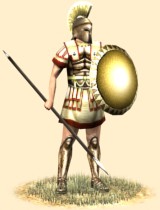Difference between revisions of "Hoplite (RTW Unit)"
From TWC Wiki
Jump to navigationJump to search (→Gameplay) |
m (→Gameplay) |
||
| Line 7: | Line 7: | ||
==Gameplay== | ==Gameplay== | ||
| − | All | + | All Hoplites have the ability to form the deadly phalanx formation. They are nearly impervious to frontal assaults, however they are generally slow and cumbersome, their rigid formation can easily be exploited with attacks to the side or rear. Generally Hoplites should be used in the Hammer and Anvil tactic Alexander The Great employed. The Hoplites hold the enemy, while another force (Be it calvary or more maneuverable infantry) destroys the enemy by the rear. It is wise to always support a Hoplite line with lighter infantry in case of Flanking maneuvers. |
==Units== | ==Units== | ||
Revision as of 18:21, 13 September 2007
The Hoplite was the backbone of Hellenic warfare, as the legionnaire would become that of the Romans.
Contents
Overview
Gameplay
All Hoplites have the ability to form the deadly phalanx formation. They are nearly impervious to frontal assaults, however they are generally slow and cumbersome, their rigid formation can easily be exploited with attacks to the side or rear. Generally Hoplites should be used in the Hammer and Anvil tactic Alexander The Great employed. The Hoplites hold the enemy, while another force (Be it calvary or more maneuverable infantry) destroys the enemy by the rear. It is wise to always support a Hoplite line with lighter infantry in case of Flanking maneuvers.
Units
Greek Cities
- Militia Hoplites
- Hoplites
- Armoured Hoplites
- Spartan Hoplites
Macedon
- Militia Hoplites
The Seleucid Empire
- Militia Hoplites
Thrace
- Milita Hoplites
